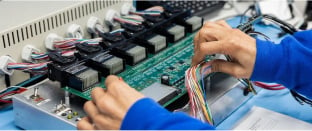Lithium-ion batteries are extremely popular and versatile. Found in cell phones, automobiles, power tools, and several other types of electronic devices, these rechargeable batteries are also making an impact powering material handling and airport ground support equipment.
The technology behind lithium-ion batteries make them a great choice because of their distinct advantages and environmentally-friendly benefits.
But, how exactly do lithium-ion batteries work? And, what makes them so popular in so many applications?
Here’s what you need to know about the components that make up a lithium-ion battery and how they work together to create high-functioning and long-lasting sources of power.
The Components
 Lithium-ion batteries are available in many different shapes and sizes. Inside, however, they typically look the same. To understand how a lithium-ion battery works, it’s important to know the role that individual parts play.
Lithium-ion batteries are available in many different shapes and sizes. Inside, however, they typically look the same. To understand how a lithium-ion battery works, it’s important to know the role that individual parts play.
The Cell
A lithium-ion battery is made up of several parts. The cell, serving as the workhorse of the battery, is the most critical component of the battery.
The cell is comprised of the following battery materials:
- Electrodes are the two battery ends. One is the anode and the other is the cathode.
- The anode stores the lithium and is typically made from carbon.
- The cathode also stores the lithium and is made from a chemical compound that is a metal oxide.
- The separator blocks the flow of negative and positive electrons inside the battery but allows for ions to pass through.
- The electrolyte liquid sits between the two electrodes. It carries the positively charged lithium ions from the anode to the cathode and vice versa depending on whether the battery is charging or discharging.
The Battery Pack
The battery pack, which holds the lithium-ion cells, operates much like a computer. It contains the following:
- At least one temperature sensor to monitor the battery’s temperature.
- A voltage converter and regulator circuit that focuses on keeping the voltage and current at safe levels.
- A Euro connector, which allows power and information to move in and out of the battery pack.
- The cell tap, which oversees the cells’ voltages in the battery pack.
- A battery monitoring system, a small computer that oversees the whole battery and ensures safety to the user.
Movement in the Cell
So how does the cell provide power to the equipment?
 When you plug a lithium-ion battery into a device or piece of equipment, the positively-charged ions move from the anode to the cathode. As a result, the cathode becomes more positively charged than the anode. This, in turn, attracts negatively-charged electrons to the cathode.
When you plug a lithium-ion battery into a device or piece of equipment, the positively-charged ions move from the anode to the cathode. As a result, the cathode becomes more positively charged than the anode. This, in turn, attracts negatively-charged electrons to the cathode.
A separator in the cell includes electrolytes that form a catalyst. This promotes ion movement between the . The movement of ions through the electrolyte solution is what causes the electrons to move through the device the battery is plugged into.
Lithium-ion batteries are rechargeable. When recharging, the lithium ions go through the same process, but in the opposite direction. This restores the battery for additional use.
The overall design of a lithium-ion battery provides many benefits for equipment users:
- Run times dramatically increase with their use compared to other battery types.
- Fast-charging capabilities provide less downtime for shift workers, and greater productivity.
- They feature flat discharge curves and provide higher constant power. This means no more annoying sluggishness in equipment as the battery charge level decreases.
Battery Management System (BMS)
The management system plays an integral role in making sure the battery cell works at its highest levels. It also impacts how the battery functions, offering several protections and features.
For example:
- The BMS maintains cell temperatures in the ideal operating range to prevent overheating or freezing.
- The BMS monitors currents and voltage to keep both at safe levels. Dendrites begin to form in the cell if voltages drop too low which can short the cell, so it is important that a lithium-ion battery pack has a system to monitor this.
- There is no “memory” built into the pack, so partial discharges do not hurt the battery. Lithium-ion batteries can charge and discharge during the times that are most convenient for equipment operators.
- Built-in controllers prevent overcharging, in order to prevent from forming that can cause significant damage to lithium-ion batteries.
- Cell balancing is monitored so that equalization charges are never needed. Because lithium-ion batteries do not need equalization charges, they do not release dangerous gasses.
- The battery management system also allows managers to track the battery health of their fleet through onboard computers that send vital data to through cloud-based services.
Lithium-ion batteries feature several elements of advanced technology that all work together to deliver distinct benefits to users.
You can learn about why lithium-ion batteries are a better option than lead-acid batteries in our article, Are Lithium-ion Better Than Lead-Acid For Forklifts?












